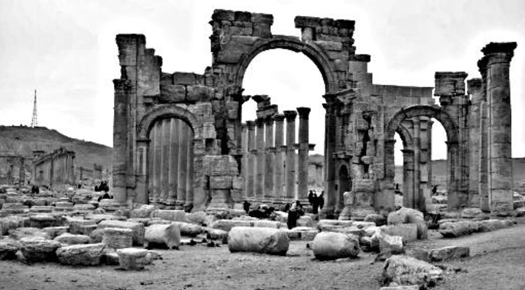
Palmyra is an ancient Semitic city in present-day Homs Governorate, Syria. Archaeological finds date back to the Neolithic period, and the city was first documented in the early second millennium BCE. Palmyra changed hands on a number of occasions between different empires before becoming a subject of the Roman Empire in the first century CE. In 2015, Palmyra came under the control of the Islamic State of Iraq and Syria (ISIS), which later destroyed a number of the site's buildings. The city was retaken by the Syrian Army on 27 March 2016 but was retaken by ISIS on 11 December 2016 and further destruction of the site followed in 2017.
Syrian authorities say recent satellite images confirm renewed devastation in the ancient oasis city, according to a statement from the Syrian Directorate General for Antiquities and Museums. "The imagery shows significant damage to the Tetrapylon and the Roman Theater, caused [as a] result of intentional destructions by ISIS," the statement said.
After recapturing the Syrian city in December, militants from the ISIS have destroyed the Tetrapylon, one of Palmyra's most famous ancient monuments, and part of its Roman theater threatening millennia-old roots of the Middle East's history.
Satellite images of Palmyra confirmed that the Tetrapylon, a Roman-era group of pillars near the city's historic entrance, now appears to have only four of its 16 columns still standing, with its stone base covered in rubble.
Omar Albenia, a spokesman of the council of Palmyra and Badia said: "We at the council of Palmyra and Badia condemn this cowardly terrorist attack carried out by ISIS and also place the blame of the Syrian regime of what is happening in Palmyra when the city of Palmyra has exchanged hands between ISIS and the Syrian regime several times." "This is a great loss for the people of Palmyra and what Palmyra stands for in history, because it is an important historical site that was well preserved over the years," he added.
Experts say the group's latest attempts to "cleanse" the history and traditions of Syria have consequences that go far beyond the region, putting the world's history at risk. Destroying one of the best preserved temples of an ancient world must be stopped. Maybe ISIS militants are sending strong messages to possible ISIS recruits that West is powerless while ISIS is destroying everything. ISIS's attempt to erase the cultural heritage of Christians, Yazidis, and other minorities in the region is a way to destroy their identity. On the other hand, the destruction has a financial motivation; the extremist group is believed to finance itself, in part, from the illegal sale of antiquities.
Photo Credits: Business Insider
